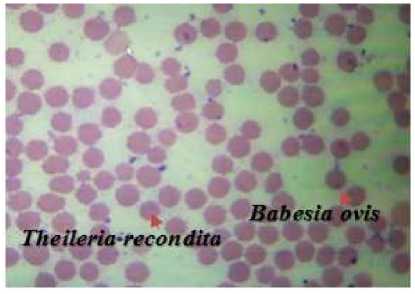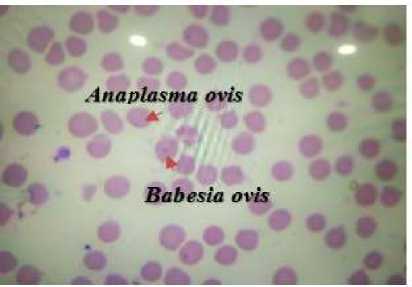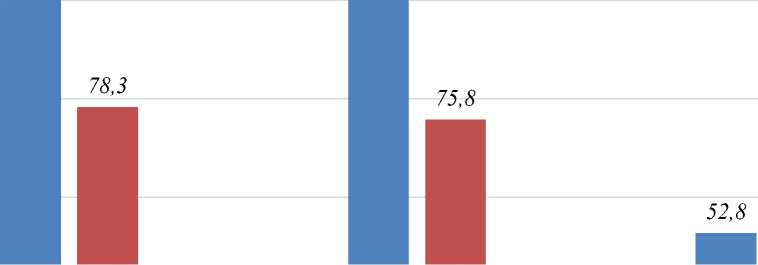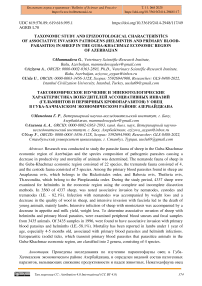Taxonomic study and epizootological characteristics of associative invasion pathogens (helminths and primary blood parasites) in sheep in the Guba-Khachmaz economic region of Azerbaijan
Автор: Mammadova G., Azizova A., Uslu U.
Журнал: Бюллетень науки и практики @bulletennauki
Рубрика: Сельскохозяйственные науки
Статья в выпуске: 8 т.11, 2025 года.
Бесплатный доступ
Research was conducted to study the parasite fauna of sheep in the Guba-Khachmaz economic region of Azerbaijan and the species composition of pathogenic parasites causing a decrease in productivity and mortality of animals was determined. The nematode fauna of sheep in the Guba-Khachmaz economic region consisted of 22 species, the trematode fauna consisted of 4, and the cestode fauna consisted of 5 species. Among the primary blood parasites found in sheep are Anaplasma ovis, which belongs to the Rickettsiales order, and Babesia ovis, Theileria ovis, Th.recondita, which belong to the Piroplasmida order. During the study period, 4337 sheep were examined for helminths in the economic region using the complete and incomplete dissection methods. In 3560 of 4337 sheep, was noted associative invasion by nematodes, cestodes and trematodes (I.E. - 82.1%). Infection with nematodes was accompanied by weight loss and a decrease in the quality of wool in sheep, and intensive invasion with fasciola led to the death of young animals, mainly lambs. Intensive infection of sheep with monieziasis was accompanied by a decrease in appetite and milk yield, weight loss. To determine associative ınvasion of sheep with helminths and primary blood parasites, were examined peripheral blood smears and fecal samples from 3435 animals. Of 3435 samples in 1996, were found to have associative invasion with primary blood parasites and helminths (I.E.-58.1%). Mortality has been reported in lambs under 1 year of age, especially 4-5 months old, associated with primary blood parasites and helminth infections. Ectoparasitic ixodid ticks, which transmit primary blood parasites that parasitize animals in the Guba-Khachmaz economic region, are classified into 2 genera, consisting of 4 species.
Parasite, pathogen, associative invasion, coprological examination, romanovsky-giemsa staining
Короткий адрес: https://sciup.org/14133536
IDR: 14133536 | УДК: 619:576.89, | DOI: 10.33619/2414-2948/117/49
Текст научной статьи Taxonomic study and epizootological characteristics of associative invasion pathogens (helminths and primary blood parasites) in sheep in the Guba-Khachmaz economic region of Azerbaijan
Бюллетень науки и практики / Bulletin of Science and Practice Т. 11. №8 2025
UDC 619:576.89; 619.616.995.1
Although humans play a key role in the development of animal husbandry, the influence of abiotic factors on this process is undeniable. Climate change in recent years - changes in the atmosphere, fluctuations in sea level, changes in the physical and chemical composition of the soil, increased temperature, annual precipitation, solar radiation, as well as excess humidity - directly affects animal health, lifestyle, productivity, reproductive ability, and the formation of parasitic fauna [5, 7, 8].
A slight change in any of the ecological factors directly affects the species composition and distribution of parasites. Abiotic factors affect the widespread distribution of parasites and cause regular reinvasions in animals [9, 11].
Intensive infestation of animals with parasites leads to a decrease in growth and weight gain, as well as mortality of young animals [13, 14].
Researchers have confirmed in experiments that sheep heavily infested with nematodes have reduced milk yield, protein and fat content [12].
In sheep over 1 year old, heavily infested with ticks, a weight loss of 3-3.5 kg was recorded [6].
The Guba-Khachmaz economic region of Azerbaijan is a region where livestock breeding is developed. Until our research, the parasitic fauna of sheep and the pathogens causing invasion in the economic region have not been comprehensively studied. Based on this, the parasitic fauna of sheep in the economic region was taxonomically studied, helminths and primary blood parasites causing invasion were identified, and intermediate hosts of pathogenic pathogens were determined. A scheme of preventive measures against invasions caused by pathogenic parasites that damage productivity in sheep was developed.
Бюллетень науки и практики / Bulletin of Science and Practice
Material and methods
The research was conducted in 2016-2023 in individual and farm livestock farms of Siyazan, Shabran, Khachmaz, Guba and Gusar districts covering the Guba-Khachmaz economic region. Pathological-anatomical materials were collected from the ecological landscapes of each region -mountainous, foothill, plain - and the results were analyzed accordingly. During the research, 4337 sheep in the Guba-Khachmaz economic region were examined for helminths using the complete and incomplete dissection method [3].
To determine associative ınvasion of sheep with helminths and primary blood parasites, were examined peripheral blood smears and fecal samples from 3435 animals. Peripheral blood samples were stained using Romanovsky-Giemsa and examined under a microscope and the species composition of piroplasmids was determined [1, 10].
To determine the genus and species composition of ixodid ticks that parasitize sheep and transmit primary blood parasites, 33,628 individual ticks were collected and identified. To determine transovarial and transstadial transmission, smears prepared from the internal organs (salivary gland, ovary, intestine) and eggs of ticks were examined for primary blood parasites. After staining the smears with Romanovsky-Giemsa stain, microscopy was performed, and the causative pathogens were determined [4].
The examinations were carried out on animals of different age groups (lambs up to 1 year old, young animals between 1 and 2 years old and sheep over 2 years old). The number of helminths per animal, the average relative coefficient of the examined and sick animals were calculated according to the “Student's t test” [2].
Results
Of the 29 species of helminth fauna of sheep studied in the Guba-Khachmaz economic region, 22 species belonged to the class of nematodes and were classified in 14 genera. 16 species of the nematode fauna of sheep – Chabertia ovina, Bunostomum trigonocephalum, Oesophagostomum venulosum, Oe.columbianum, Trichostrongylus axei, Tr.vitrinus, Ostertagia ostertagi, O.circumcincta, Marshallagia marshalli, Haemonchus contortus, Cooperia oncophora, Nematodirus abnormalis, N. spathiger, Dictyocaulus filaria, Protostrongylus kochi, P. hobmaieri -were found with high extensiveness and intensity in the mountainous, foothill and plain landscapes of the economic region. In sheep, more intense and associative infection with nematodes of the species Oesophagostomum venulosum, Trichostrongylus axei, Ostertagia ostertagi, Marshallagia marshalli, Haemonchus contortus, Nematodirus abnormalis, Dictyocaulus filaria and Protostrongylus kochi was observed. In this economic region, 16 species of nematodes have been identified that cause nematodosis in sheep with high intensity.
Four species of trematodes causing serious damage to productivity in sheep have been recorded in the economic region. Of the 4 species of trematodes found in sheep in the Guba-Khachmaz economic region, 3 species – Fasciola hepatica, Dicrocoelium lanceatum and Paramphistomum cervi were recorded with high extensiveness and intensity. Although in previous years, trematode infestations in sheep were more common in spring and autumn, in recent years, intense cases of infestation have also been observed in summer. Invasion of sheep with trematodes of the species Fasciola hepatica and Dicrocoelium lanceatum was observed more intensively and associatively.
The fauna of cestodes of sheep in the Guba-Khachmaz economic region is represented by 5 species belonging to 4 genera: Moniezia expansa, M. benedeni, Avitellina centripunctata, Echinococcus granulosus and Cysticercus ovis . Two species of cestodes, M. expansa and E. granulosus , were found in all landscapes of the economic region with high extensiveness and
Бюллетень науки и практики / Bulletin of Science and Practice Т. 11. №8 2025 intensity. Although no mortality was observed in sheep affected by monieziasis, decreased appetite and milk yield, weight loss were noted. The cestode A. centripunctata was detected at low intensity in sheep under 1 year of age infected with M. expansa.
Of 3435 samples in 1996, were found to have associative invasion with primary blood parasites and helminths (I.E.-58.1%). It was determined primary blood parasites parasitized in sheep in the economic region - Anaplasma ovis belonging to the Rickettsiales order and Babesia ovis , Theileria ovis and Th.recondita belonging to the Piroplasmida order. The main blood parasites causing piroplasmosis were identified as A. ovis and B. ovis species, while the protozoa Theileria ovis and Th. recondita were reported as non-pathogenic species (Figure 1).

Figure 1. Primary blood parasites in peripheral blood smear samples

In sheep infected with pathogenic protozoa A.ovis and B.ovis, eggs of the nematodes Oesophagostomum venulosum, Trichostrongylus axei, Ostertagia ostertagi, Marshallagia marshalli, Haemonchus contortus, Nematodirus abnormalis, Dictyocaulus filaria, Protostrongylus kochi, trematodes Dicrocoelium lanceatum and cestodes Moniezia expansa were found in coprological samples (Figure 2). Mortality has been observed in lambs up to 1 year old, especially 4-5 months old, associated with primary blood parasites and helminth infections.

Figure 2. Intensity of invasion with nematodes, trematodes and cestodes in sheep infected with primary blood parasites (in one field of view of the microscope)
To determine associative ınvasion of sheep with helminths and primary blood parasites, were examined peripheral blood smears and fecal samples from 3435 animals. 730 sheep in Siyazan district, 840 in Shabran district, 700 in Khachmaz district, 650 in Guba district, and 515 in Gusar district were examined to determine associative invasion. Associative invasion with helminths and primary blood parasites was recorded in 345 (47.3%) of 730 sheep studied in Siyazan district, 376 (44.8%) of 840 sheep studied in Shabran district, 540 (77.1%) of 700 sheep studied in Khachmaz
Бюллетень науки и практики / Bulletin of Science and Practice Т. 11. №8 2025 district, 480 (73.8%) of 650 sheep studied in Guba district, and 255 (49.5%) of 515 sheep studied in Gusar district. In the Siyazan district, nematode + piroplasmid was detected in 345 sheep with primary blood parasites B. ovis, Th. ovis, Th. recondita (100%), and trematode + nematode + piroplasmid associative invasion was observed in 270 (78.3%).
In the Shabran district, nematode+piroplasmid associative invasion was noted in 376 sheep, in which primary blood parasites B. ovis, Th. recondita were detected (100%), and trematode+nematode+piroplasmid associative invasion was noted in 285 (75.8%).
In the Khachmaz district, out of 540 sheep in which primary blood parasites B.ovis and A.ovis were detected, nematode+piroplasmid associative invasion was observed in 285 (52.8%), trematode+piroplasmid in 156 (28.9%), and cestode+piroplasmid in 99 (18.3%). In the Guba district, out of 480 sheep in which primary blood parasites B. ovis and A. ovis were detected, nematode+piroplasmid associative invasion was observed in 93 (19.4%), trematode+piroplasmid in 142 (29.6%), and cestode+piroplasmid in 245 (51.0%). Of the 255 sheep in Gusar district where the primary blood parasite A. ovis was detected, nematode+piroplasmid associative invasion was observed in 48 (18.8%), trematode + piroplasmid in 68 (26.7%), and cestode + piroplasmid in 139 (54.5%) (Figure 3).

Figure 3. Dynamics of associative invasion of sheep with piroplasmid and helminths by region
The species composition of ectoparasitic ticks that transmit primary blood parasites was relatively different across economic regions. In the Guba-Khachmaz economic region, ixodid ticks in sheep were classified into 4 species - Hyalomma plumbeum, H. anatolicum, Rhipicephalus bursa, Rh. turanicus and 2 genera. Although in the first month of winter heat-loving Hyalomma ticks were also observed to parasitize sheep ,blood-parasitic diseases were not observed in animals.
Analysis of the conducted studies shows that in the economic region, infection of sheep with primary blood parasites B. ovis and A. ovis is accompanied by associative invasion with the trematode D. lanceatum and the cestode M. expansa , which causes serious economic damage. This form of associative invasion causes growth retardation, weight loss and even death of lambs. This is due to the weakening of the immune system in lambs infected with helminths and increased susceptibility of animals to primary blood parasitic diseases. To protect farms from economic losses, animals must first be regularly dewormed and freed from ticks, which are carriers of primary blood parasites.


